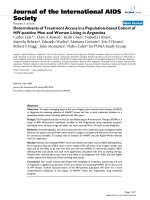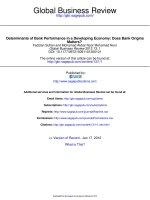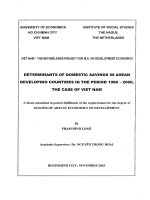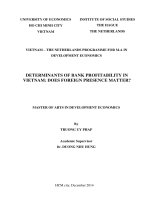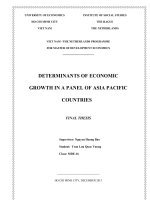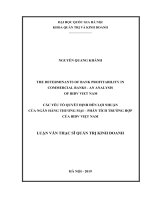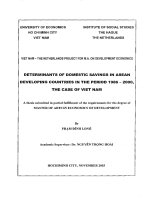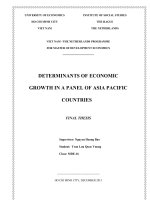DETERMINANTS OF BANKS’ PROFITABILITY IN a DEVELOPING ECONOMY, EVIDENCE FROM NIGERIA
Bạn đang xem bản rút gọn của tài liệu. Xem và tải ngay bản đầy đủ của tài liệu tại đây (187.03 KB, 15 trang )
97
ISSN 2029-4581. ORGANIZATIONS AND MARKETS IN EMERGING ECONOMIES, 2013, VOL. 4, No. 2(8)
DETERMINANTS OF BANKS’ PROFITABILITY
IN A DEVELOPING ECONOMY:
EVIDENCE FROM NIGERIA
Tomola Marshal Obamuyi*
Adekunle Ajasin University
Abstract. e unimpressive banks’ performance in Nigeria over the last decade has remained a source
of concern for all and sundry. is study investigates the eects of bank capital, bank size, expense
management, interest income and the economic condition on banks’ protability in Nigeria. e
xed eects regression model was employed on a panel data obtained om the nancial statements of
20 banks om 2006 to 2012. e results indicate that improved bank capital and interest income, as
well as ecient expenses management and favourable economic condition, contribute to higher banks’
performance and growth in Nigeria. us, government policies in the banking system must encourage
banks to regularly raise their capital and provide the enabling environment that will accelerate
economic growth in the country. Bank management must eciently manage their portfolios in order to
protect the long run interest of prot-making.
Key words: Banks’ protability, developing economy, policies in the banking system, Nigeria
1. Introduction
Banks’ performance in Nigeria over the last decade remained unimpressive. e prot
before tax (PBT) of the banks uctuated, especially between 2002 and 2005, and has
declined progressively since 2008. For instance, the prot before tax which was 80.8% in
2000 fell dramatically and recorded a loss of 13.95%. Although PBT peaked at 287.62%
in 2007, it nose-dived to 49.14% in 2008 (see Obamuyi, 2012). is implies that the
opportunities for banks in Nigeria to make prots are gradually reducing. e declining
prots could have been caused by the global economic crises, the festering crises in
the banking sector and the fact that some of the criteria usually employed to measure
the performance of the banks have been compromised by the Central Bank of Nigeria
(Obamuyi, 2011). As Olokoyo (2011) argues, the current trend in Nigerian banking
and nance sector suggests that the days of cheap prots are now over and only banks
with well conceptualized lending and credit administration policies and procedures can
survive the emerging competition. e implication of all the statements above is that
*
Department of Banking and Finance, Adekunle Ajasin University, Akungba-Akoko, Ondo State, NIGERIA.
Email:
98
banking habits have been seriously threatened thereby discouraging savings culture and
hence reducing the amount of funds that can be mobilized by banks. By extension, the
protability of the banks, regarded as a key measure of nancial performance for any
company, has been negatively aected. e foregoing conrms the worry of Sharma
and Mani (2012) that the performance of banks has become a major concern for
economic planners and policy makers due to the fact that the gains of the real sector
of the economy depend on how eciently the banks are performing the function of
nancial intermediation. As Saona (2011) argues, an ecient nancial system improves
banks’ protability by increasing the amount of funds available for investment, while
enhancing the quality of services provided for the customers. us, important role of
banks arises because, by facilitating the use of external nance, they assist in reconciling
the nancial interest of the decit economic units, which invest more than they save,
with those of the surplus economic units, which save more than they invest (Ojo,
2010), thereby generating reasonable income in the process.
Although the monetary authorities have taken some measures (such as banks’
consolidation, review of prudential guidelines and bail-out strategy) to stabilize the
nancial system and build condence in the banking system, it is still germane to know
what factors aect banks protability in order to inuence policy making in the banking
sector in Nigeria. us, the study investigates the eects of capital, size, expenses
management and economic condition on banks’ protability in Nigeria. It is hereby
hypothesized that, ‘there exists a signicant relationship between banks’ protability
and each of the banks’ capital, size, expenses management and economic condition in
Nigeria. e study becomes relevant because it will invoke the aention of the policy
makers and the bank management to pursue policies that have long lasting positive
implications on the entire banking system in Nigeria. e study provides additional
knowledge for researchers and the general public about factors aecting banks’
protability in Nigeria.
e outline of the study is as follows: aer the introduction, there is the literature
review, which is also followed by the methodology of the study. e results and
conclusion are presented in sections four and ve respectively.
2. Literature Review
2.1 Theoretical Issues
is study examines some of the theories relating to capital and protability as well
as bank size and protability. e theories include the signaling theory, expected
bankruptcy cost hypothesis, risk-return hypothesis, market power and eciency
structures hypotheses.
e relationship between capital and protability is explained by signaling theory
(Berger, 1995; Trujillo-Ponce, 2012), expected bankruptcy cost hypothesis and risk-
return hypothesis (Athanasoglou, Brissimis & Delis, 2005; Olweny & Shipho, 2011).
99
e signaling hypothesis suggests that a higher capital is a positive signal to the
market of the value of a bank (see Ommeren, 2011). As Berger (1995) and Trujillo-
Ponce (2012) observe, under the signaling theory, bank management signals private
information that the future prospects are good by increasing capital. us, a lower
leverage indicates that banks perform beer than their competitors who cannot raise
their equity without further deteriorating the protability (Ommeren, 2011). On the
other hand, bankruptcy hypothesis argues that in a case where bankruptcy costs are
unexpectedly high, a bank holds more equity to avoid period of distress (Berger, 1995).
As the literature review pointed out, the signaling hypothesis and bankruptcy cost
hypothesis support a positive relationship between capital and protability. However,
the risk-return hypothesis suggests that increasing risks, by increasing leverage of the
rm, leads to higher expected returns. erefore, if a bank expects increased returns
(protability) and takes up more risks, by increasing leverage, the equity to asset
ratio (represented by capital) will be reduced. us, risk-return hypothesis predicts a
negative relationship between capital and protability (Dietrich and Wanzenrid, 2009;
Ommeren, 2011; Saona, 2011; Sharma and Gounder, 2012).
Consequently, the Market Power (MP) and Eciency Structure (ES) theories
explain the relationship between the bank size and protability. Olweny and Shipho
(2011) observe that the market power posits that performance of banks is inuenced by
the market structure of the industry and that the Eciency Structure (ES) hypothesis
maintains that banks earn high prots because they are more ecient than the others.
Concluding on the MP and ES theories, Olweny and Shipho (2011) argue that MP
theory assumes that the protability of a bank is a function of external market factors,
while the ES assume that bank protability is inuenced by internal eciencies.
2.2 Empirical Evidence
e empirical review of the study is done by identifying similarities and dierences
across the various economies studied by previous researchers. e factors aecting
banks’ protability have been empirically examined by many authors, especially in
the developed countries. Demirgüç-Kunt and Huizinga (1999), using bank level
data for 80 countries in the 1988-1995 periods, showed that dierences in interest
margins and banks’ protability reect a variety of determinants: the characteristics
of the bank, macroeconomic conditions, explicit and implicit bank taxation, deposit
insurance regulation, overall nancial structure, and several underlying legal and
institutional indicators. Athanasoglou et al. (2005) studied the eect of bank-specic,
industry-specic and macroeconomic determinants of bank protability, using an
empirical framework that incorporates the traditional Structure-Conduct-Performance
(SCP) hypothesis. e results indicated that all bank-specic determinants, with the
exception of size, aect bank protability signicantly in the anticipated way. Saona
(2011) examined the determinants of the protability of the US banks during the
period 1995-2007. e empirical analysis combined bank specic (endogenous) and
100
macroeconomic (exogenous) variables through the GMM system estimator. He found
a negative link between the capital ratio and the protability, which supports the notion
that banks are operating over-cautiously and ignoring potentially protable trading
opportunities. Sco and Arias (2011) also investigated the primary determinants of
protability of the top ve bank holding companies in the United States. e ndings
of Sco and Arias (2011), which were also highlighted by Rahman and Farah (2012),
show that protability determinants for the banking industry include capital to asset
ratio, annual percentage changes in the external per capita income and internal factor
of size (as measured by an organization’s total assets). Staikouras and Wood (2004)
constructed the OLS and xed eect models to examine the determinants of European
bank protability from 1994 – 1998. e authors found that the protability of
European banks is inuenced not only by factors related to their management decisions
but also to changes in the external macroeconomic environment.
Khrawish (2011) accessed the Jordanian commercial bank protability from 2000
through 2010, and categorised the factors aecting protability into internal and
external factors. e author found that there is signicant and positive relationship
between return on asset (ROA) and the bank size, total liabilities/ total assets, total
equity/ total assets, net interest margin and exchange rate of the commercial banks
and that there is signicant and negative relationship between ROA of the commercial
banks and annual growth rate for gross domestic product and ination rate. Dietrich
and Wanzenrid (2009) analysed the protability of commercial banks in Switzerland
over the period 1999 to 2006. eir ndings revealed that the most important factors
are the GDP growth variable, which aects the bank protability positively, and the
eective tax rate and the market concentration rate, which both have a signicantly
negative impact on bank protability. Macit (2011) investigated the bank specic
and macroeconomic determinants of protability in participation banks for Turkish
banking sector using ROA and ROE. He found that for the bank specic determinants
of protability, the ratio of non-performing loans to total loans has a signicant negative
eect on protability. e result is consistent with the study by Davydenko (2010) in
the Ukraine. Macit (2011) also found that the log of real assets has a signicant positive
eect on protability. Riaz (2013) investigated the impact of the bank specic variables
and macroeconomic indicators on the protability of banks in Pakistan during the
period of 2006- 2010. When ROA is taken as a dependent variable, he determined that
the credit risk as well as the interest rate has a signicant inuence on the commercial
banks’ protability in Pakistan.
Flamini, McDonald and Schumacher (2009) investigated the determinants of bank
protability in 41 Sub-Saharan African (SSA) countries, using a sample of 389 banks.
e study proved that apart from credit risk, higher returns on assets are associated
with larger bank size, activity diversication, and private ownership. e results also
indicate that bank returns are aected by macroeconomic variables, suggesting that
macroeconomic policies that promote low ination and stable output growth do
101
boost credit expansion. Sharma and Gounder (2012) investigated the protability
determinants of deposit–taking institutions in Fiji, over the 2000–2010 period. e
study used panel data techniques of xed eects estimation and generalized method
of moments (GMM). e authors discovered that Market power (measured by the
Lerner Index) is a key determinant of protability. us, institutions were allowed to
pass on to their clients the interest costs of raising deposit liabilities and the overall cost
of operations. Naceur and Goaied (2008) observed a positive relationship between
capital and net interest margin or protability in Tunisia, but determined that the bank
size impacts negatively on protability, which implies that Tunisia banks are operating
above their optimal level. Olweny and Shipho (2011) evaluated the eects of banking
sectoral-factors on the protability of commercial banks in Kenya, using panel data from
2002 to 2008 of 38 commercial banks. e authors concluded that the bank-specic
factors are more signicant factors inuencing the protability of commercial banks
in Kenya than market factors. e study revealed that protable commercial banks are
those that strive to improve their capital bases, reduce operational costs, improve assets
quality by reducing the rate of non-performing loans, employ revenue diversication
strategies as opposed to focused strategies and keep the right amount of liquid assets.
Aburime (2008) investigated the determinants of bank protability in Nigeria,
using a panel data from 1980-2006. He found that real interest rates, ination, monetary
policy, and exchange rate regime are signicant macroeconomic determinants of bank
protability in Nigeria, while banking sector development, stock market development,
and nancial structure are insignicant. Also, Oladele, Sulaimon and Akeke (2012)
found that operating expense, relationship between cost and income, and equity to
total assets signicantly aects the performance of banks in Nigeria. Ani et al. (2012)
established that capital and asset composition positively aect bank protability, while
bank size has negative eect on protability in Nigeria. Also, Babalola (2012) used
four models (an aggregated model coupled with three other decomposed models) to
investigate the determinants of protability in Nigeria. His ndings showed that in the
short run, capital adequacy ratio is the determining factor for bank protability. e
literature reviewed above has shown the consistency of some of the internal (bank-
specic) factors like capital, size and credit risks in determining bank protability
across dierent economies of the world. e external (macroeconomic) factors of
gross domestic product growth rate and interest rate have also been prominent in the
determination of bank protability. Consequently, the review shows that return on
assets (ROA) and return on equity (ROE) are the most common criteria employed as
measures of protability by most researchers. However, a search in the literature on the
determinants of banks’ protability indicates that only scanty empirical research, using
few banks and/or economic variables, can be found in Nigeria. erefore, the study
contributes to the literature by empirically re-conrming (or otherwise) the results of
the previous studies, especially with regard to Nigeria’s situation.
102
3. Methodology
3.1 Data Collection
e panel secondary data (comprising cross-sectional and time-series data) for the study
were obtained from the reports of the 20 banks in existence as at the end of 2012. e
cross-sectional element is reected by the dierent Nigerian banks and the time series
element is reected in the period of study (2006 – 2012). As Saona (2011) observes,
the main advantage of using panel data is that it allows overcoming of the unobservable,
constant, and heterogeneous characteristics of each bank included in the study. e
names of the banks in alphabetical order are: Access Bank, Citibank, Diamond Bank,
Ecobank Nigeria, Enterprise Bank (formerly Oceanic Bank), Fidelity Bank Nigeria,
First Bank of Nigeria, First City Monument Bank, Keystone Bank Limited (formerly
Bank PHB), Guaranty Trust Bank, Mainstreet Bank Limited (formerly Afribank), Skye
Bank, Stanbic IBTC Bank Nigeria Limited, Standard Chartered Bank, Sterling Bank,
Union Bank of Nigeria, United Bank for Africa, Unity Bank Plc, Wema Bank and Zenith
Bank. Data on GDP growth were compiled from the Central Bank of Nigeria Statistical
Bulletin.
3.2 Description of Variables
3.2.1 Dependent Variable
Researchers have employed dierent measures of protability to determine the factors
aecting banks’ performance. For instance, the measures of protability employed (and
the authors) include: return on assets (Flamini et al., 2009; Sco & Arias, 2011; Oladele et
al, 2012; Babalola, 2012); return on equity (Saona, 2011); return on assets and return on
equity (Athanasoglou et al., 2005; Dietrich & Wanzenrid, 2009; Rasiah, 2010b; Khrawish,
2011; Ali, Akhtar & Ahmed, 2011; Macit, 2012; Sharma & Gounder, 2012; Riaz, 2013);
return on assets, return on equity and return on deposits (Jahan, 2012); return on assets
and net interest margins (Demirgüç-Kunt & Huizinga, 1999; Naceur & Goaied, 2008);
return on assets, return on equity and net interest margins (Suan & Habibullah, 2009;
Naceur & Omran, 2011; Qin & Pastory, 2012); return on assets, return on equity, prot
margin (BTP/TA) and net interest margins (Hassan & Bashir, 2005).
e return on assets (ROA) is a nancial ratio used to measure the relationship of
earnings to total assets. ROA is regarded as the best and widely used indicator of earnings
and protability supplemented by return on equity (ROE) and return on deposits
(ROD) (Jahan, 2012). Studies have shown that ROA assesses how eciently a bank
is managing its revenues and expenses, and also reects the ability of the management
of the bank to generate prots by using the available nancial and real assets (see
Jahan, 2012). e net interest income (NIM) refers to the net income accruing to the
bank from non-interest activities (including fees, service charges, foreign exchange,
and direct investment) divided by total assets. e bank’s before-tax prot over total
assets (BTP/TA), as a measure of the bank’s prot margin, is calculated from the bank’s
103
income statement as the sum of non-interest income over total assets minus overhead
over total assets minus loan loss provision over total assets minus other operating
income (Hassan & Bashir, 2005).
For this study, bank protability is proxied by return on assets (ROA), dened as
the banks’ aer tax prot over total assets. ROA is considered as the key proxy for bank
protability, instead of the alternative return on equity (ROE), because an analysis of
ROE disregards nancial leverage and the risks associated with it (Flamini et al., 2009).
3.2.2 Independent Variables
Bank-Specic Determinants
Most of the studies on bank protability have categorized the determinants of
protability into internal and external factors (Rasiah, 2010b; Naceur & Omran,
2011; and Khrawish, 2011). Furthermore, Sastrossuwito and Suzuki (2012) refer to
the internal factors as the bank-specic determinants of protability, while the external
factors refer to the macroeconomic determinants of protability.
Capital: Capital refers to the amount of own funds available to support a bank’s
business and, therefore, bank capital acts as a safety net in the case of adverse
development (Athanasoglou et al., 2005). Capital is calculated as the ratio of equity to
total assets. e ratio measures how much of the banks’ assets are funded with owners’
fund and is a proxy for capital adequacy of a bank by estimating the ability to absorb
losses (Ommeren, 2011). Based on past literature, the relationship between capital
and protable is said to be unpredictable (Sharma & Gounder, 2005). is is because
while positive relationship had been found by some studies (Berger 1995; Demirgüç-
Kunt & Huizinga, 1999; Hassan & Bashir, 2005; Athanasoglou et al. 2005; Dietrich
& Wanzenrid, 2009; Davydenko (2010); Olweny & Shipho, 2011; Ommeren, 2011;
Ani et al., 2012; and Rao & Lakew, 2012), other studies found a negative relationship
between capital and protability (Saona, 2011; Ali et al., 2011; Qin & Pastory, 2012).
Staikouras and Wood (2004) argue that a positive (negative) coecient estimate for
capital indicates an ecient (inecient) management of banks’ capital structure.
Bank Size: Bank size accounts for the existence of economies or diseconomies of
scale (Naceur & Goaied, 2008). e variable is measured as the natural log of total
assets (Saona, 2011). Economic theory suggests that market structure aects rm
performance (Haron, 1996) and that if an industry is subject to economies of scale,
larger institutions would be more ecient and could provide service at a lower
cost (Rasiah, 2010a). Also, the theory of the banking rm asserts that a rm enjoys
economies of scale up to a certain level, beyond which diseconomies of scale set in. is
implies that protability increases with increase in size, and decreases as soon as there
are diseconomies of scale. us, literature has shown that the relationship between
the bank size and protability can be positive or negative (Staikouras & Wood, 2004;
Athanasoglou et al., 2005; Flamini et al., 2009; Dietrich & Wanzenrid, 2009; Naceur &
Omran, 2011).
104
Expenses Management: Expenses management relates to the idea of ecient
management of banks’ resources. For this study, the variable measures the ratio of
operating expenses to total assets. As Athanasoglou et al. (2005) observe, a negative
relationship is expected between expenses management and protability, since
improved management of the expenses will increase eciently and hence raise prots.
Macroeconomic Determinants
Interest Rate: e bank lending rate is expected to have a positive impact on bank
protability. is is because interest rate directly impacts bank interest income and
expenses, and the net result that further aects protability.
Dummy of Real GDP Growth: the real GDP growth is used as a proxy of business
cycle in which banks operate, and controls for variance in protability due to dierences
in business cycles which inuence the supply and demand for loans and deposits
(Staikouras & Wood, 2004; Ommeren, 2011). In this study, GDP is used as a dummy
in dening favourable/unfavourable conditions, i.e., a dummy of the shi in economic
activities (GDP) from favourable (1) to unfavourable (0) conditions. us, higher
(lower) GDP indicates favourable (unfavourable) business opportunities under which
a bank can achieve higher (lower) protability. is is because an increase in economic
activities of the country signals that customers’ demand for loans will increase, and with
improved lending activities, banks are able to generate more prots.
3.3 Method of Analysis
e paper made use of both descriptive and econometric analyses. e descriptive
approach was used to analyze the means and further shows the normality of the
distribution. A preliminary estimation of the correlation coecients of the variables
was carried out in order to determine the explanatory variables that would nally
appear in the regression model.
e econometric approach examines the main factors aecting banks’ protability
in Nigeria by applying xed eects model. e results of the xed eects would be
compared to that obtained from the random eects through the Hausman (1978)
specication test. e specication of the model for the study is based on the empirical
works of Demirgüç-Kunt and Huizinga (1999), Athanasoglou et al. (2005), Flamini et
al. (2009) and Saona (2011). Five explanatory variables are included in the regression
analysis. e empirical model takes the following form:
k
ROA
it
= α + ΣβkY
k
+ ε
it
(1)
k=1
it
ε
it =
v
i +
u
it ,
105
where ROA
it
is the return on asset (bank prot over total assets) and represents the
protability of bank i at time t, with i = 1, 2, , N, t = 1, 2, , T, α is a constant term, Y
it
is a vector of k explanatory variables and ε
it
is the disturbance with v
i
the unobserved
bank-specic eect and u
it
the idiosyncratic error.
Based on the reviewed literature, vector Y consists of some independent variables,
categorized as internal factors (Y
p
it
), and external factors (Y
q
it
). Hence, Y
it
can be divided
into two groups as:
P Q
ROA
it
= α + ΣβpY
p
+ ΣβqY
q
+ ε
it
(2)
p=1
it
q=1
it
e internal (bank-specic) control variables (Y
p
it
) are bank capital (ratio of equity
to total assets), bank size (natural log of total assets) and expenses management (ratio
of operating expenses to total assets). e external (macroeconomic) control variables
(Y
q
it
) refer to the variables of bank interest (lending) rate and the dummy of the GDP
growth rate.
Meanwhile, some reliability tests were also carried out in the study. e coecient
of determination (R
2
), also known as the goodness of t that describes how well the
model ts a set of observation, was employed to measure the degree of relationship
existing among the variables. e statistic would show the percentage of total variation
in dependent variable that is explained by the independent variables. e Durbin-
Watson (D-W) statistic was also used to nd out whether there is the incidence of
autocorrelation among the variables in the model.
4. Analysis and Results
4.1 Results of the Descriptive Statistics
Table 1 presents the results of the descriptive statistics of both the dependent and
independent variables for the panel data analysis of the study.
From the results in Table 1, the analysis of the means shows the following descriptive
statistics: protability (M = 0.018, SD = .008); capital (M = 0.185, SD = 0.058); bank
size (M = 5.803, SD = 0.298); expenses management (M = 0.036, SD = 0.013); interest
rate (M = 0.216, SD = 0.023); and GDP dummy (M = 0.429, SD = 0.495). e analysis
indicates that the bank size has the highest means (M = 5.503), with the deviation from
the mean at 29.8%. e lowest standard deviation for protability (0.008) indicates
that the data are clustered around the mean and thus more reliable. e Jargue-Bera
statistic indicates that all the data series are normally distributed. is is indicated by
the probability values of JB statistic which for those series are signicantly dierent
from zero at 1% signicant level. In any case, evaluating normality indicates that the
acceptable range of - 1.0 to + 1.0 was satised for all the variables.
106
4.2 Discussions of Econometric Results
Table 2 below presents the results of the correlation analysis for the study in order to
determine the level of association among the variables.
TABLE 2: Results of Correlation Analysis
Protability
(ROA)
Capital Bank Size
Expense
Manage-
ment
Interest
Rate
Dummy
of GDP
Protability 1.000000
Capital 0.463869 1.000000
Bank Size 0.461605 0.266741 1.000000
Expense
Management
0.094419 0.390377 -0.634071 1.000000
Interest Rate 0.587544 0.582986 0.840168 -0.346919 1.000000
Dummy of GDP 0.584098 0.279562 -0.196947 0.702975 -0.135515 1.000000
e results in Table 2 indicate that a positive correlation exists between protability
and each of the independent variables (capital, bank size, expenses management, interest
rate and the economic condition of the country). us, the correlation coecients
indicate that an improvement in bank capital, bank size, expense management, interest
rate and the economic condition of the country leads to higher prots for the banks.
e results of the correlated random eects - Hausman test (not shown here),
performed to decide between xed or random eects, indicate that the xed eects
model is more suitable than the random eects model (chi2 = 0.001). e regression
results in Table 3 are based on the xed eects model.
TABLE 1: Descriptive Statistics for the Variables
Protability
(ROA)
Capital Bank Size
Expenses
Management
Interest
Rate
Dummy of
GDP
Mean 0.017873 0.184985 5.803475 0.036113 0.216386 0.428571
Median 0.017788 0.165529 5.861511 0.039897 0.218600 0.000000
Maximum 0.033912 0.273878 6.180629 0.053369 0.246100 1.000000
Minimum 0.004223 0.086377 5.241929 0.019274 0.182100 0.000000
Std. Dev. 0.008205 0.058220 0.297715 0.013391 0.022927 0.495124
Skewness 0.402427 -0.003260 -0.714299 -0.098053 -0.320979 0.288675
Kurtosis 3.194664 2.205381 2.359084 1.249007 1.666516 1.083333
Jarque-Bera 27.99876 25.78472 100.1097 126.7643 89.43681 163.6169
Probability 0.000001 0.000003 0.000000 0.000000 0.000000 0.000000
Sum 17.51540 181.2850 5687.406 35.39060 212.0580 420.0000
Sum Sq. Dev. 0.065909 3.318342 86.77271 0.175549 0.514591 240.0000
Observations 980 980 980 980 980 980
107
From the results in Table 3, the xed eects coecients of the regressors indicate how
much protability changes when there is a change in the capital of each bank, bank size,
expenses management, interest rate and economic condition of a country. From Table 3,
the overall regression is statistically signicant, F = 48.40, p = .001, thus supporting the
fact that capital, size, expenses management, interest rate and the economic situation of
a country are important factors in determining the protability of the banks in Nigeria.
e coecient of multiple determinations (R
2
), which indicates the quality of tness
of the model, shows that about 89.30% of the changes in protability of the banks in
Nigeria are caused by the combined inuence of the independent variables of the bank
capital, bank size, expenses management, interest rate and the economic situation of the
country. With a value of 89.30%, the strong positive relationship between protability
and its determinants is further conrmed. e results of the Durbin Watson Statistics
of 2.026 indicates that there is no autocorrelation among the variables included in the
model, making the model more reliable.
e relationship between protability and capital is positive and statistically
signicant. e results imply that the banks with larger capital are able to diversify
their business operations by strengthening their ability to assume risk and aract funds
at low cost, which will enhance their liquidity position. e overall eect will be an
improvement of their lending, with positive eect on protability. As Athanasoglou
et al. (2005) observe, a bank with a sound capital position is able to pursue business
opportunities more eectively and has more time and exibility to deal with problems
arising from unexpected losses, thus achieving increased protability. e results
conrm the study by Saona (2011) and Bourke (1989). For instance, Bourke (1989)
found that capital ratios are positively related to protability under the assumption
that well capitalized banks may enjoy access to cheaper and less risky sources of funds
TABLE 3: Results of the Fixed Eects Regression
Dependent Variable: Protability (ROA)
Variable Coecient Std. Error t-Statistic Prob.
Constant 0.066257 0.005025 13.18541 0.0000
Capital 0.012692 0.003304 3.841583 0.0001
Bank Size -0.020236 0.001013 -19.97304 0.0000
Expenses Management -0.538509 0.023125 -23.28645 0.0000
Interest Rate 0.359810 0.010755 33.45668 0.0000
Dummy of GDP 0.019362 0.000358 54.15272 0.0000
R-squared 0.893006 Mean dependent variable 0.017873
Adjusted R-squared 0.874554 S.D. dependent variable 0.008205
S.E. of regression 0.002906 Akaike info criterion -8.708214
Sum squared residual 0.007052 Schwarz criterion -7.985056
Log likelihood 4412.025 Hannan-Quinn criterion -8.433094
F-statistic 48.39693 Durbin-Watson statistic 2.026122
Prob(F-statistic) 0.000000
108
and beer quality asset markets. Berger (1995) and Saona (2011) aribute the two
potential explanations for the positive relationship between the bank’s prots and the
capital ratios to the expected bankruptcy costs hypothesis and the signaling hypothesis.
e result is consistent with the works of Naceur and Goaied (2008), Sco and Arias
(2011), and Oladele et al. (2012).
Bank size has a negative but statistically signicant eect on banks’ protability
(ROA). e results indicate that banks are likely to earn fewer prots as compared to
small banks. e negative relationship could be that, as the banks are becoming extremely
large, the bureaucratic procedures have negatively aected their performances. For
instance, the forced mergers and acquisitions of banks in Nigeria in 2006, where the
number of banks were reduced from 89 banks to 24 groups of banks in 2006, could have
caused the returns of the banks to decline. us, policy makers should be cautious and
understand, as Shih (2003) argues, that the acclaimed synergy from banks’ mergers is
not automatic, and that the returns from the bank merger are more likely to be negative
than positive. e results conrm the works of Staikouras and Wood (2004) and Ani et
al. (2012) that growing banks may face diminishing marginal returns which will cause
average prots to decline with size.
e expenses management variable has a negative and signicant eect on banks’
protability as expected. is nding implies that ecient management of banks’
expenses, by reducing the cost of operations, improves the performance of the banks.
e most important policy lesson to the banks is that reducing the cost of operations
reduces the incidence of failure of the banks and hence strengthens the condence of
the shareholders and the public through improved nancial performance of the banks.
us, as stated by Eciency Structure (ES) hypothesis, an eciently managed bank
will earn higher prots than the less ecient ones.
In line with the researcher’s expectation, the variable of interest rate was positive
and statistically signicant. is implies that the prots of banks tend to increase with
increasing rate of interest. is is understandable in Nigeria because, oentimes, most
banks charge high rate of interest on loans and advances because of their perceived
risk of doing business in the country. Since the borrowers have no readily available
alternative sources of borrowing to nance their investments, the availability doctrine,
rather than the cost doctrine, has been the only option. is means that they are ready,
at whatever cost, to obtain loans from the banks as far the loans are available. e higher
interest rates benet the banks in terms of higher prots, but at the expense of the
overall economic development of the country.
Expectedly, the dummy of GDP variable has positive and statistically signicant
relationship with protability. e positive eect is an indication that higher GDP
represents improved business opportunities, which ultimately leads to higher
protability. e result is consistent with theory as documented in the studies by
Dietrich and Wanzenrid (2009), and Flamini et al. (2009).
109
5. Conclusions
e paper investigates the eects of capital, size, expenses management, interest rate
and economic condition on banks’ protability in Nigeria. ese factors aecting
banks’ protability were categorized as bank-specic variables (bank capital, size and
expense management) and macroeconomic variables (interest rate and GDP, proxy for
business cycle).
Several sources of theoretical and empirical reviews were used to support the
relationship between protability and each of its determinants. e theories include
the signaling theory, expected bankruptcy cost hypothesis, risk-return hypothesis,
market power and eciency structures hypotheses. e econometric model of xed
eects regression was employed for the study, using a panel data (comprising cross-
sectional and time-series data) of 20 banks in Nigeria between 2006 and 2012.
e results conrm some previous ndings that the bank capital, expenses
management, interest rate and the economic situation of the country have statistically
signicant eects on banks’ protability in Nigeria. e results indicate that improved
bank capital and interest income, as well as ecient management of banks’ expenses
and favourable economic condition contribute to higher banks’ performance and
growth in Nigeria. Accordingly, the impact of GDP growth rate on protability indicates
that banks can achieve higher (lower) protability under favourable (unfavourable)
conditions. Government policies in Nigerian banking sector must encourage banks to
regularly raise their capital and provide the enabling environment that will accelerate
economic growth in the country. ese results have important implications for banks’
survival and growth. It is hoped that the study will guide the policy makers and bank
regulators in the formulation and implementation of macroeconomic policies which
may aect the stability of the banking system in Nigeria.
Acknowledgements
e author is highly indebted to the two anonymous reviewers and the Editor of OMEE
for the insightful comments which have helped to improve the quality of the paper. e
author also remained grateful to Professor Homann Paolo Saona of the Department
of Business and Economics, Saint Louis University-Madrid Campus, Madrid, Spain, for
his support and comments throughout the period of writing the paper.
References
Aburime, T. U. (2008). Determinants of Bank Protability: Macroeconomic Evidence om
Nigeria (September 2). Available at SSRN: hp://ssrn.com/abstract=1231064 or hp://dx.doi.
org/10.2139/ssrn.1231064.
Ali, K., Akhtar, M. F. & Ahmed, H. Z. (2011). Bank Specic and Macroeconomic Indicators of
Protability – Empirical Evidence from the Commercial banks of Pakistan. International Journal of
Business and Social Science, 2(6), 235 – 242.
110
Ani, W.U., Ugwunta, D.O., Ezeudu, I. J. & Ugwuanyi, G. O. (2012). An Assessment of the
Determinants of bank Protability in Nigeria: Bank Characteristics Panel Evidence. Journal of
Accounting and Taxation, 4(3), 38 – 43.
Athanasoglou, P. P., Brissimis, S. N. & Delis, M. D. (2005). Bank-Specic, Industry-Specic and
Macroeconomic Determinants of Bank Protability. Bank of Greece Working Paper 25. Available at:
hp://www.bankofgreece.gr/BogEkdoseis/Paper200525.pdf
Babalola, Y. A. (2012). e Determinants of Bank’s Protability in Nigeria. Journal of Money,
Investment and Banking, 24, 6 – 16.
Berger, A.N. (1995). e Relationship between Capital and Earnings in Banking. Journal of
Money, Credit and Banking, 27, 432 – 456.
Bourke, P. (1989). Concentration and other determinants of bank protability in Europe, North
America, and Australia. Journal of Banking and Finance, 13, 65-79.
Davydenko, A. (2010). Determinants of Bank Protability in Ukraine. Undergraduate Economic
Review, 7(1/2). Available at: hp://digitalcommons.iwu.edu/uer/vol7/iss1/2
Demirgüç-Kunt, A. & Huizinga, H. (1999). Determinants of Commercial Bank Interest Margins
and Protability: Some International Evidence. e World Bank Economic Review, 13(2), 379 – 408.
Available at: hp://www.jstor.org/stable/3990103.
Dietrich, A. & Wanzenried, G. (2009). Determinants of Bank Protability Before and During
the Crisis: Evidence from Switzerland. Journal of International Financial Markets, Institutions and
Money, 21 (3), 307-327.
Flamini, V., McDonald, C. & Schumacher, L. (2009). e Determinants of Commercial Bank
Protability in Sub-Saharan Africa. International Monetary Fund Working paper, WP/09/15. Available
at: hp://www.imf.org/external/pubs//wp/2009/wp0915.pdf
Haron, S. (1996). Competition and other External Determinants of the Protability of Islamic
Banks. Islamic Economic Studies, 4(1), 49-64.
Hassan, M.K. & Bashir, A. H. (2005). Determinants of Islamic Banking Protability. In Munawar
Iqbal and Rodney Wilson (Eds.), Islamic Perspectives on Wealth Creation, Edinburgh: Edinburgh
University Press.
Jahan, N. (2012). Determinants of Bank’s Protability: Evidence from Bangladesh. Indian Journal
of Finance, 6(2), 32 – 38.
Khrawish, H. A. (2011). Determinants of Commercial Banks Performance: Evidence from
Jordan. International Research Journal of Finance and Economics, 81, 148-159.
Macit, F. (2011). Bank Specic and Macroeconomic Determinants of Protability: Evidence
from Participation Banks in Turkey. Economics Bulletin, 32(1).
McKinnon, R. (1973). Money and Capital in Economic Development. Washington: e Brookings
Institute.
Naceur, S. B. & Goaied, M. (2008). e Determinants of Commercial Bank Interest Margin and
Protability: Evidence from Tunisia. Frontiers in Finance and Economics, 5(1), 106-130.
Naceur, S. B. & Omran, M. (2011). e eects of bank regulations, competition, and nancial
reforms on banks’ performance. Emerging Markets Review, 12(1), 1-20.
Obamuyi, T. M. (2011). Incessant Bank Distress and the Policies of Central Bank of Nigeria.
International Journal of Finance and Accounting, 1(1), 121 – 13.
Obamuyi, T. M. (2012). Financial Development and Economic Growth in Emerging Markets:
e Nigerian Experience. Indian Journal of Finance, 6(4), 16-27.
Ojo, A. T. (2010). e Nigerian Maladapted Financial System: Reforming Tasks and Development
Dilemma (1st ed.). Lagos: Chartered Institute of Bankers of Nigeria Press Limited.
Oladele, P. O., Sulaimon, A. A. & Akeke, N. I. (2012). Determinants of Bank Performance in
Nigeria. International Journal of Business and Management Tomorrow, 2(2), 1 – 4.
111
Olokoyo, F. O. (2011). Determinants of Commercial Banks’ Lending Behaviour in Nigeria.
International Journal of Financial Research, 2(2), 61-72.
Olweny, T. & Shipho, T. M. (2011). Eects of Banking Sectoral Factors on the Protability of
Commercial Banks in Kenya. Economics and Finance Review, 1(5), 01-30.
Ommeren, S. V. (2011). An Examination of the Determinants of Banks’ Protability in the
European Banking Sector, An Unpublished M. Sc. esis, Department of Accounting and Finance,
Erasmus School of Economics Erasmus University, Roerdam.
Qin, X. & Pastory, D. (2012). Commercial Banks Protability Position: e Case of Tanzania.
International Journal of Business and Management, 7(13), 136 – 144.
Rahman, S. N. & Farah, T. (2012). Non Bank Financial Institutions’ Protability Indicators:
Evidence from Bangladesh. International Journal of Applied Research in Business Administration and
Economics, 1(1), 26-32.
Rao, K. R. M. & Lakew, T.B (2012). Determinants of Protability of Commercial Banks in a
Developing Country: Evidence from Ethiopia. International Journal of Accounting and Financial
Management Research, 2(3), 1-20.
Rasiah, D. (2010a). Review of Literature and eories on Determinants of Commercial Bank
Protability. [Article]. Journal of Performance Management, 23(1), 23-49.
Rasiah, D. (2010b). eoretical Framework of Protability as Applied to Commercial Banks in
Malaysia. European Journal of Economics, Finance and Administrative Sciences, 19, 74 – 97.
Riaz, S. (2013). Protability Determinants of Commercial banks in Pakistan, Proceedings of 6
th
International Business and social Sciences Research Conference, 3-4 January, Dubai, UAE. Available
at: hp://www.wbiconpro.com/603-Samina.pdf.
Saona, P. H. (2011). Determinants of the Protability of the US Banking Industry. International
Journal of Business and Social Science, 2(22), 255 – 269.
Sastrosuwito, S. & Suzuki, Y. (2012). e Determinants of Post-Crisis Indonesian Banking
System Protability. Economics and Finance Review, 1(11), 48-57.
Sco, J. W. & Arias, J. C. (2011). Banking Protability Determinants. Business Intelligence Journal,
4(2), 209-230. Available at: hp://www.saycocorporativo.com/saycouk/bij/journal/vol4no2/
article_1.pdf.
Sharma, E. & Mani, M. (2012). Impact of Macroeconomic and Financial Market Indicators
on the Banking Sector: Some Evidence from India. International Journal of Research in Finance and
Marketing, 2(2), 172-185.
Sharma, P. & Gounder, N. (2012). Protability Determinants of Deposit Institutions in Small,
Underdeveloped Financial Systems: e Case of Fiji. Grith Business School Discussion Papers
Finance, No. 2012 – 06. Available at: hp://equella.rcs.grith.edu.au/research/items/ inancial-
systems.pdf.
Staikouras, C. K. & Wood, G. E. (2004). e Determinants of European bank Protability.
International Business and Economic Research Journal, 3(6), 57 – 68.
Suan, F. & Habibullah, M. S. (2009). Determinants of Bank Protability in a Developing
Economy: Empirical Evidence from Bangladesh. Journal of Business Economics and Management,
10(3), 207-217.
Trujillo-Ponce, A.(2012). What Determines the Protability of Banks? Evidence from Spain,
Accounting and Finance, 53(2), Available at: www.aeca.es/pub/on_line/comunicaciones_
xvicongresoaeca/ /75b.pdf
